Scientific Shimmy: Why we Dance
This week the Naked Scientists are hitting the dance floor with a look at the science of the shimmy. Why do we do it, what makes a dance look good, and how can it be used to help people? Plus, in the news; how glowing lungs can fight infections, an app the reduces the symptoms of OCD, and we look at the future of the Internet...
In this episode

00:50 - Spotting lung infections with glowing bacteria
Spotting lung infections with glowing bacteria
with Professor Kev Dhaliwal, University of Edinburgh
Around the world, about 20 million people need a ventilator to breathe. Ventilator patients are some of the most critically ill, and they are particularly vulnerable to picking up lung infections like pneumonia. But, because time is so short for these patients, doctors don’t have time to properly diagnose the infection, which can take days, and so they end up being given lots of emergency antibiotics. As well as using up resources, this adds to the already significant global problem of antibiotic resistance.
Now, scientists have developed a new way of rapidly seeing bacteria in patients’ lungs at the hospital bedside, which they hope could be used to confirm a suspected diagnosis within seconds, and also monitor the progress of treatments. Clinician and researcher Kev Dhaliwal from the University of Edinburgh took part in the research, and he spoke to Katie Haylor...
Kev - One of the biggest challenges faced by humanity at the moment is the rise of antimicrobial resistance and the lack of antibiotics we have in the pipeline. We need to better steward what we have currently, but also to make sure we’re giving the right class of antibiotics to the patient otherwise we drive resistance. And in some scenarios, such as intensive care with very sick patients, we give very broad spectrum antibiotics. We need to stop antibiotics that we don’t need to give because there are many side effects and also it drives resistance. So the idea here was to develop a bedside technology that could give us the results within seconds.
Katie - Can you walk us through your new technique?
Kev - You can call them “molecular light bulbs” or “fluorescent Smarties.” They’re chemicals that will bind to targets, and light up when they bind to the target. We spray them into the area we’re interested in, then we pass a small microscope and look for this light and that’s what we’re seeing. So the paper and the work we describe is the ability to spray these ‘smart probes’ as we call them, or these molecular light bulbs in. They hit the target and they light up, and we actually take the detector right into the distal part of the lung.
Katie - So you’ve got a molecule which is capable of emitting a light signal and that’s what, bound to something that reacts to the bacteria?
Kev - Yeah. The core technology was around an antibiotic that we modified that only binds to certain types of bacteria that we then put this fluorophore on, and it only lit up when it touched that bacteria. So the fluorophore embeds itself into the membrane of a bacteria, and the membrane of bacteria have got different environments that can make fluorophore light up from zero to high levels.
Katie - So what information do you end up with then at the bedside?
Kev - We start seeing clumps of bacteria sparkling in front of us. One of the biggest challenges we have to do now is to understand whether that is just bacteria that were there already and what levels there were, or is this a real infection. So what we’re trying to do in studies moving forwards is now take this out to many more patients now that we’ve proven we can see the bacteria in the lung. And in the small series that we’ve done, we think that indicates real new infection to validate that in hundreds of people to show that we can actually definitively diagnose this condition - pneumonia - within sixty seconds on a ventilator.
We also have other molecular light bulbs that pick up other signatures of infection, so inflammatory cells for instance. So we’d like to think of this as a bit like a rainbow: green is the light we’re seeing in the bacteria but can also pick up red, magenta and other signals when we put other smart probes in. So what we’re about to do now is take this to the next level. We’re going to actually spray in a combination of these probes that pick up both inflammation, which is the host’s or the human’s response to infection, and the bacteria to give us this unique signature. These are not just bacteria that are sitting there, these are bacteria that are actually causing nasty damage.
We have developed now probes that tell us the class of bacteria. That can direct the type of antibiotic we give. So what we’re moving towards is actually the ability for these smart probes to also be able to tell us that the bacteria are alive or dead. Now that wasn’t part of this study that we published, but that’s where we’re moving to, the ability to show that antibiotics are actually working. Because often we give antibiotics and we don’t know the dose that we’re giving is correct in these patients, and we’re not entirely sure whether they penetrate the tissue to kill the bacteria, so monitoring treatment efficacy is a key goal.
Katie - Can you give us an indication of how significant this new technique could be?
Kev - We spent many years and decades as scientists using animal models or things in dishes and thinking we know what’s going on inside a human being. We’ve never been able to actually see real bacteria real infections in humans before at the bedside in patients who are acutely unwell. But the ability now, to do molecular microscopy inside human beings, we can actually understand disease processes so I think, from our perspective, we’re excited because it’s the beginning of that journey.

05:50 - App shown to help with OCD symptoms
App shown to help with OCD symptoms
with Professor Barbara Sahakian, University of Cambridge
OCD, or obsessive compulsive disorder, is a condition affecting just over 1 in 100 people. OCD often causes ritualised behaviours, like repeated hand washing, and a fear of contamination, which can have a serious impact on people’s work, their mental health, and their relationships. Now, a team from the University of Cambridge have designed a smartphone app for people with the condition, and early studies have shown it can help improve symptoms. Georgia Mills spoke to Barbara Sahakian, Professor of Clinical Neuroscience at the University of Cambridge.
Barbara - Although some people trivialise it because they think: “handwashing, that’s not too bad”. I mean the point is that some of these people are so severe in terms of their symptoms of contamination fears that they actually pour bleach on their hands, or even sometimes they can’t even leave the house because they’re so concerned that touching anything in a public place might contaminate them in some way. So it’s a very serious illness.
Georgia - What kind of therapies do exist at the moment?
Barbara - Well, at the moment, the most common one is a form of cognitive behavioural therapy and it’s called ‘Exposure and Response Prevention’, so it’s a very special form. What happens is maybe a psychologist or somebody helps them go through the treatment where, when they have contamination fears, they have to say touch a toilet seat, or maybe even put their hands down a toilet and then they’re prevented from washing their hands. Initially they get very anxious, as you might expect, but slowly they habituate in the exposure to this and makes them essentially become unafraid and they lose the contamination fear. But many patients don’t want to go through this treatment because it makes them so worried and anxious.
Georgia - Is this what inspired you? Why did you set out to design this app?
Barbara - Yeah. We set out to design the app because the two treatments that there are: the cognitive behaviour therapy or the drugs, which are the selective serotonin reuptake inhibitors or SSRIs, like Prozac, only about 60 percent of patients respond to that, so there’s about about 40 percent that get no relief from the treatments.
So what we’ve done, we’ve got these apps; one is an app where you see yourself washing your hands, and the other app is where you see yourself touching these sorts of disgusting objects, which are obviously related to contamination fears. And what we’ve found is that people do this four times a day for a week, they actually get much better in terms of their symptoms; their symptoms are greatly reduced. And also we find that they become more cognitively flexible because basically, cognitive rigidity is associated with carrying out these rituals, these habits and so forth.
Georgia - What do you mean when you say cognitive flexibility?
Barbara - Well, sort of being very adaptive to things and sort of being able to switch to think of new things and not get stuck in these ritualistic behaviours.
Georgia - Right. And so you mentioned there’s a video on the app of them washing their hands, so could you talk me through how someone using the app: when they’d use it and how they’d use it?
Barbara - They’re asked to use it four times a day and they’re sort of keyed when to use it, and they have a window of opportunity to use it. So they touch whether they’re feeling well and how they’re feeling, and they rate their anxiety levels at that point. And then they watch they app and we put circles on the app, which they have to recognise and count so we’re sure that they’re actually looking at the app. And they’ve been very accurate about that and so we know that they watch the app when it comes on. Then afterwards they rate again how anxious they are and we’ve had really good reports back.
Some of the people say “I didn’t used to be able to go on the bus because I didn’t want to touch anything and sit on seats that people had been sitting on, but now I find I can just look at my app and see myself washing my hands and I feel much better”. And other people who had the other one that’s more kin to a CBT type therapy say that “I used to not be able to wash the counter or take my bins out but now I find I don’t really have a problem with that. So they both seem to reduce the symptoms by about 21 percent which is great.”
Georgia - So, where as a cognitive behavioural therapy you can’t really carry that around with you in your pocket, but with an app it’s there for when you need it?
Barbara - Yes. And it’s really personalised medicine because it’s their own hands that they’re watching wash or touch these objects. Our paper was recently published in the journal Scientific Reports, and it’s available to download open access.
Georgia - When might people be able to download the app?
Barbara - We have one more experiment we’d like to conduct just to make sure that people with very severe symptoms also get benefits from it, and hopefully after that it will be released.
Georgia - You mentioned it has benefits compared to cognitive behavioural therapy but what percentage of people responded to it compared to the people who would respond to CBT?
Barbara - Basically, everybody continued and used the app the whole time, which is very good because often there’s a lot of dropout from the cognitive behavioural treatments or people can’t even engage with them. So actually we’ve got quite beneficial effects very consistently across the different participants.

11:21 - The future of the Internet
The future of the Internet
with Peter Cowley, Angel Investor
Chances are, you’ve used the Internet today. Whether you’re at work, doing some on-line banking, checking social media, or indeed reading this text, you’re connected to the online world. But over half of everyone on the globe doesn’t have access to the internet. And the growth of people coming online has slowed down according to a new report, with affordability sighted as a major blockade to progress.
To learn more Izzie Clarke spoke to tech guru and Angel Investor Peter Cowley to find out about the spread of Internet accesss...
Peter - Yes. It’s spread, of course, as you’d expect, in the developed world more. To give you some idea of the numbers, something like 98 percent of people are online in Iceland, about 85 to 90 percent in Australia, South Africa, US, and 75 percent in Japan but only 1.2 percent in Eritrea. So the actual access in Sub-Saharan Africa is going to be low digits, and the Un expected that to get to 100 percent by 2020. At the moment it’s still under 50 percent.
The reason these reports came out and we’re talking about this is because it’s actually slowing down, so it’s only about 6 percent a year. So the chances of it getting to 100 percent inside 30 to 40 years is pretty impossible. Where internet access is actually classed as somebody having access once every three months so, compared with us, the people in this studio for instance and the people listening that’s a tiny fraction.
Izzie - Why is access important though?
Peter - I think we all know that, as listeners to this programme, there’s all kinds of things that you can’t really do nowadays without some sort of internet access. Whether that’s education - not all education of course, but payments, booking tickets, etc. There is a study that actually deduced that for every 10 percent increase in internet access it’s linked to a 1.35 increase in GDP, so turning developing countries into developed internet access obviously contributes a tremendous amount.
Izzie - Why isn’t everyone online?
Peter - There are social things, certainly in the Sub-Saharan in Africa which is being concentrated on this report because women are not allowed to spend money on that. There’s obviously is a completely different dynamic between men and women in those countries, so having an asset isn’t allowed. A lot of the technological, the biggest issue, of course, is affordability. The cost of putting a mobile infrastructure in place in order to give access over the wireless, because you can't have copper in the ground for these sort of countries, is that there isn’t enough income coming in from those users to provide that. So what’s happens about that, basically, it’s got to be done with some sort of aid from other countries, which then leads to issues with other countries having control over these developing countries and all the political effects of that.
Izzie - Well, that’s what I was going to ask. What can be done? Is something happening to change all of that?
Peter - Yeah. There’s assistance with things like regulation, with providing funding for submarine cables to some of these countries, etc. But there are two interesting technical projects here: one is called the Google Project Loon, which is very thing balloons sitting above an area at this 20 kilometer point where they move around slowly but not too fast, and they transmit from the ground up to the balloons and back down again - that’s one project. And then, of course, Elon Musk is doing this with spaceX he’s doing something and he’s put up many thousands of moving satellites which would float around the world at about 700 miles, 1100 kilometres above Earth, all interconnected. These two projects, of course, are being funded at the moment by the big tech giants but, in time, will be taken over and that will make a massive difference because half the population, 3.8 billion people, are not yet connected.
Izzie - So how important is universal internet access then? Does everyone need to be online essentially?
Peter - Well no. In fact, one of my children lives in Geneva and he’s got a group of friends who refuse point blank to be online, so they have smartphones without any data access, they use just voice and text messages. If you think of what’s happening in terms of many things you actually need, if you want to book an airline ticket with one of the cheaper carriers you’ve got to have internet access. It helps with payments, particularly in developing countries, which then helps with trade. It helps with people moving vegetables and fruit around the place. There’s a huge number of reasons why internet access is actually beneficial.
It has downsides, of course, as well, like with fake news.
Izzie - And so I guess, very quickly, is internet access even affecting our behaviour? I know there have been things about negatively, but also positively. I would imagine, like you said, if you could improve something like agriculture then internet access would be incredibly important towards behaviour?
Peter - Yeah. Payments, transactions, media consumption if that matters. Social interaction for people in some places it makes a massive difference. News, education. The downsides are addiction, which does occur. Fake news, attention span being shortened. Physical human interaction becoming less important. Is that good for the globe? Not sure it is. And, of course, lack of trust, that’s the big one. People are not necessarily trusting things that they meet on the internet.
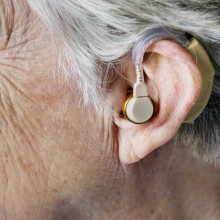
16:31 - Solving the cocktail party problem
Solving the cocktail party problem
with Ken Roberts, Audiotelligence
Anyone with hearing aids will be able to tell you that having a conversation in a busy restaurant is just about impossible. As hearing loss affects almost everyone at some point in their life, one Cambridge based company has set out to solve what's termed the cocktail party problem. To find out more, Georgia Mills went to visit the chief executive of Audiotelligence, Ken Roberts to test out his technology in a slightly noisy pub...
Ken - If you talk to people who wear hearing aids you’ll find very often that actually they’ll turn them off in a noisy pub, or even take them out because actually it’s easier to try and focus in on a single person speaking than working with hearing aids that are really high quality amplifiers; but they amplify all of the sounds that you don’t want to listen to as well as the sound that you do.
Georgia - But we have come here armed with some very snazzy looking, bleeping and flashing technology. What is your secret weapon?
Ken - Basically, what we have on the table here is a mini PC. On top of the mini PC is a small circuit board with 8 microphones. It’s roughly around the same size and shape as a mobile phone, which is intentional. Our software running on the mini PC actually uses the information from those 8 microphones to figure out where the individual sources are in the acoustic scene around us. And by doing that we can separate out the one that we’re interested in and get rid of all the background noise that we’re really not interested in. And that’s really the difference between what we do and what a hearing aid does. A hearing aid amplifies all of that acoustic scene, but by doing that it actually amplifies the background noise, whereas we separate the source that you’re interested in from the background noise.
Georgia - And how this works at the moment is with a little visualisation of the sound in the room on an iphone. It looks like a doughnut with flashing lights where people are speaking and if you want to focus on a particular person, you select the corresponding flashing light. And here’s a comparison of Ken speaking first without, and then with, the technology being turned on.
Ken - Incomprehensible muttering.
Georgia - I’m going to have to turn it back on because I can’t hear properly. Lets get it back on yes.
Ken - Yeah. I think that’s a good example of the difference that the technology delivers.
Georgia - Does it have any other applications?
Ken - Yes, absolutely. One of the biggest growth areas in the world today is home assistance and speech recognition. And one of the big challenges that automatic speech recognition software has is being fed a clean signal. About 30 percent of errors that speech recognition software has are due to noisy signals, so by inserting our technology ahead of your speech processor, we can feed a clean denoised signal. So again, just like the environment here, we could get rid of all the background noise and greatly improve the recognition rates for speech recognition technologies.

19:24 - Dying coral reefs make fish less aggressive
Dying coral reefs make fish less aggressive
with Dr Sally Keith, Lancaster University
In 2016 there was an unexpected and unprecedented mass bleaching of the coral reefs around the world due to rising sea temperatures leading to losing huge amounts of our coral reefs. Coincidentally, at this time, a team of researchers were in the process of studying butterfly fish who are sensitive to changes in the reef. The timing meant that they were able to determine the effect of coral bleaching on these reef inhabitants. Tamsin Bell spoke with Dr Sally Keith from Lancaster University who explores how aquatic species respond to environmental change by studying fishy behaviour in coral reefs. Sally, who led the research, started by explaining the process of coral bleaching...
Sally - The water gets too hot and the corals expel the algae that live inside them, and this is what makes them turn a white colour, so it’s called bleaching because the corals go white. And this doesn’t mean they’re dead at that point so sometimes they can recover if the temperatures are not high for too long but, unfortunately, sometimes it can also cause them to die. And this one in 2016 was the biggest one in recorded history and we had very high coral death after that event.
What we wanted to look at was specifically butterfly fishes. They’re very brightly coloured fish that eat corals so they’re very very dependent on the health of the reef, and we wanted to understand how their behaviour was changing in response to environmental change.
Tamsin - How have you been studying these fish?
Sally - I’ve spent a lot of time underwater for the last few years watching fish. About 600 hours across 17 different reefs in the central Indo-Pacific region. We’re generally on snorkel with a clipboard and a bit of waterproof paper and a pencil, and we watch a fish for five minutes and we record any other fish that are also butterfly fish that come within one metre of it. At that point we say that there’s been an encounter, and we got a total of 5,259 encounters recorded between individuals, and that was across 38 different species of fish.
Now that encounter can go one of two ways; either they don’t care that the other one’s there so it’s passive, there’s no response, or they can get very very angry and chase the other individual away and so that indicates aggression. And the reason they do that is because they’re defending their corals that they want to eat in their territory from this other individual.
Tamsin - I see. So from all this work you’ve done, what have you found?
Sally - Before bleaching happened, when we were watching these fish 15 percent of their interactions were aggressive, so fairly often they ended up chasing each other when they came into contact. But after the bleaching, we had a two thirds decrease in aggression, so it was only every 1 in 20 times they met each other that they chased. And what we think has happened is that because the most nutritious corals are gone first, they’ve gone past the point of being ‘hangry’ so, originally, when the resource starts to reduce they get more aggressive. They’ve gone past that point now, where there’s so little for them to eat that they just don’t have the energy to invest in fighting.
Tamsin - Oh wow! So they just can’t be bothered?
Sally - Exactly.
Tamsin - So what implications does this have?
Sally - It’s really demonstrating a sort of intermediate mechanism. So we know that after about 5 years or 7 years after bleaching we tend to have fewer fish individuals on a reef, but we don’t really know the process of how that happens, and so it seems like this change in behaviour might indicate to us what’s going on. And so, if they don’t have the energy to invest in fighting, and that’s because they’re eating a less nutritious diet, it means either they might end up starving over time because they’ve got enough food to keep going for a little while but not to keep surviving in the long term.
The other possibility is that, although they’ve got enough energy to survive themselves, they don’t have enough energy to produce the next generation of fish. And because these fish have quite a short lifespan that might explain why we have this time lag, so it’s really trying to get at the underlying mechanism that’s driving the ultimate reduction in fish numbers.
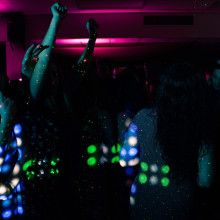
24:35 - The science of good dancing
The science of good dancing
with Dr Nick Neave, Northumbria University
It’s all well and good for those on Strictly Come Dancing or Dancing with the Stars, who have a professional dancer helping them every step of the way, but are there some universal dancing rules that make something look good? What is it that makes someone an appealing dancer? Adam Murphy spoke to Nick Neave, from Northumbria University, to learn about looking good on the dancefloor...
Nick - We took a sample of males; we asked for volunteers. We didn’t ask for people who were professional dancer we just wanted the normal guys off the street, and we were very interested in having people look at these videos of people dancing and not be distracted by anything else. Previous research that had been done on male movements had kind of used blurred images of people, and we realised that those images were still giving off information that might be distracting. So, for example, you could tell the size of the body, the shape of the body, the skin colour, how tall the person was, and we know those things are very important for mate perception so we wanted to remove all those things.
So in our methodology, we videoed people in a motion capture system. They were kind of wearing shorts and a t shirt and you stick these little reflective markers on them, which actually don’t hinder their movement at all. The cameras don’t actually see the person, all they see is these little markers that turns these people into kind of moving blobs of light. With some fancy software, we then recreate the people as computer generated avatars and, very importantly, those avatars are all exactly the same.
Adam - So what do these avatars look like? Could you describe them for me?
Nick - Yeah. Well you know, they’re standard little computer generated figures. Kind of shiny robots if you like. They’re humanoid, an action man type figure, but it’s very interesting that they are incredibly realistic in terms of the movement, so when a person moves in real life that movement is translated across into the avatars. And, of course, because the computer knows where all of these anatomical markers are, it means that we can then calculate very very precise biomechanical differences. So we can calculate movement angles, movement trajectories, movement velocities, all of these things that we can measure to kind of come up with a way of measuring a person’s movement.
Adam - And what kind of things did you find at the other end?
Nick - What we essentially found was that the quality of a male’s dance was very strongly associated with the movements of his upper body, so kind of shoulders, arms, head, neck, chest. Those things seemed to be what people focus on when they’re looking at male dancers. That was kind of surprising. We thought that there’d be a lot of leg action there that people would be very focused upon legs, how fast the legs were moving, but that didn’t seem to be the case. Women and men are focusing on men's’ upper bodies.
We then did some further research where we got our volunteers and we measured how strong they were. We used things like grip strength dynamometer test and, low and behold, what we found was that the strength of the male was accurately signified by their dance quality, so stronger men were rated as being better dancers.
Adam - You said upper body movements were important, what kind of upper body movements? What looks good, I guess?
Nick - Yeah. It is odd because if you think we say that these movements are very kind of vigorous movements and very big movements, and very kind of strong and powerful movements. But the guy that just stands there and kind of flings his arms around in kind of wild abandon, that’s kind of crazy. The males who were making bigger and stronger, and faster and more powerful movements with their arms and upper body, they were preferred but, after a certain point, that gets to be not preferred. There’s a very fine line being regarded as a poor dancer and being regarded as a good dancer, and then if you try too hard you then become a bad dancer again.
Adam - Is it moving the arms the same or up or down, or what is it that looks best?
Nick - In that initial study we weren’t able to tell. We just found that the kind of strength and the size and the speed of the movements seemed to be important. We then did a second study because we realised that there was bits here that we didn’t fully understand. This time we recruited females; we did exactly the same thing, and what we found in this case was that for female dancers, that upper body was completely unimportant, it was all about the legs and the hips, specifically the movements of the hips.
And what we did find in the female dancers was that there was a degree of asymmetry which seemed to be important. So, for example, if the left leg is doing something, the right leg should be doing something slightly different, but the optimum dance seems to be where the legs and the arms are working independently from one another but are still working together. We think that this demonstrates the kind of ideal physical state in that somebody who can do something with their left arm and their left leg, and something slightly different with their right arm and right leg. That seems to indicate a very good level of coordination, perhaps creativity, efficiency of the motor system. That’s what we think these honest signals are, are underlying these movements.
Adam - If someone felt they were a total no-hoper when it came to dance, what advice would you give them?
Nick - It’s very simple actually. What we found is, and we spoke to a lot of choreographers, we spoke to a lot of professional dancers, and it seems to be that the root of good dance is all about having a core strength in your body. So a person who hasn’t got that strength isn’t going to be a good dancer at all, so start off with things like yoga classes, pilates classes. Develop that core body strength and then by taking dance classes you can very very quickly develop rhythm and timing and you can learn to do these things properly. Now, they’ll never win Strictly, but they will be able to achieve a very good level of dance.
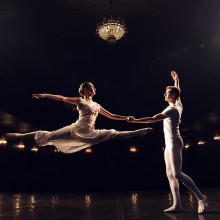
Why do we dance?
with Professor Ian Cross, University of Cambridge
We know what looks good when we’re watching dancers, but why do we bother doing it in the first place? Where did it come from and how linked is it to music? Georgia Mills spoke to Ian Cross, Professor of Music at Cambridge University to learn about the evolution of dance...
Ian - Probably the same reason that language evolved: to enable us to engage with each other, and primarily to engage with each other socially.
Georgia - Do we know when it came?
Ian - No, we really don’t. It’s unlikely to have happened before we became particularly bipedals, so it’s going to be post-australopithecine.
Georgia - I do like the idea of apes in trees sort of jigging around.
Ian - Well, interesting you should say that. Until a couple of years ago, I didn’t really believe any of the evidence that suggested that chimpanzees could keep in time with each other until I saw some material from the Kyoto Primate Lab in Japan, which showed pretty unambiguously that chimps can tap along in time with each other. In other words, chimps could do something like dance with each other but, only if they’re good mates or they’re related.
Georgia - Right. They don’t want to dance with strangers then?
Ian - No.
Georgia - Just like most of us.
Ian - And that’s probably the difference between them and us that we can dance with strangers. There’s some very interesting ethnographic evidence; for instance when the first fleet landed in Botany Bay in Australia in 1788 - sorry, invaded Australia - more or less the first thing that happened was that some of the sailors danced with some of the indigenous peoples.
Georgia - You mentioned we think that dance evolved because of a social thing, is there anything else it might be good for and has anyone done these studies into this?
Ian - We did a study about three or four years ago where we looked at people dancing together and the effect that that had on memory. We used silent disco technology to enable us to have two groups of people dancing in the same space but to different pieces of music. Silent disco technology, for those who don’t know - wireless headphones with a base station. The base station can broadcast the music, and you’ve usually got two or three or maybe half a dozen different channels on the base station. We used two different channels, two different pieces of music, so half the people were dancing to one piece and half were dancing to a different piece at a different tempo, different speed.
Georgia - And what effect did that have on people's memory did you say?
Ian - Well, what we did is control the ways in which they could interact with each other. So everyone spent as much time in proximity to people dancing at the same tempo as dancing at the different tempo. People were wearing different coloured sashes and half of them were wearing badges. What we found was that people remembered the colour of the sashes that people dancing to the same tempo were wearing, and remembered whether or not people dancing to the same tempo were wearing badges. But didn’t remember nearly so well when they were dancing to a different tempo.
Georgia - So dancing might actually help us remember things about the people we're dancing with? Why would that be a good thing evolutionary speaking?
Ian - Well, what you are remembering are incidental features; features that are not focally attended to. It’s pretty good just to check up, “can I cope with this person? Can I engage with this person? Will I be able to communicate with this person?”. And if you add another layer to it then, of course, the whole sex thing comes into it. But we’re talking about a level here way below that which is just general sociality.
Georgia - I see. So you’re having a nice dance with someone, maybe had a bit to drink and you dance really well with them. But then, who were they? And then you remember what colour sash they had on.
Ian - That could be one aspect. Some other research has shown we’re more likely to like people we have been in time with than people we’ve been out of time with.
Georgia - I guess that’s similar to how they make people do marching together for armies and things. It’s very important, isn’t it?
Ian - Yeah. It is a process of bonding. At that level, to distinguish between music and dance becomes a bit silly because in most world cultures they are the same thing.
Georgia - I was going to ask about that because music is another thing that’s very linked with dancing, and you say that they’re sort of the same in many cultures?
Ian - Yeah, absolutely. And in many respects the same in this culture. In Nigeria, for instance, in Igbo what we might think of as music is “nkwa”, which is music, singing, dancing and having a good time.
Georgia - Right. So they’re all one word?
Ian - Yeah.
Georgia - That’s a lovely word.
Ian - It is. And it’s a much more sensible word than music, which kind of partitions out an area of human experience, or dance which again partitions our another area, which are closely linked.
Georgia - Do we know what happens in a brain when a great tune comes on, and your foot starts tapping away and you just want to have a boogy? What’s going on inside our minds to cause this reaction?
Ian - One of the interesting things that happens when we hear music is that the bit of the brain that’s involved for planning for action, the supplementary motor area, there’s activation. The supplementary motor area; there’s activation. A meter analysis of all the studies that have looked at people just listening to music in a scanner showed that one area that was consistently activated was the supplementary motor area. So you could say that a response to listening to music is to prepare to move.
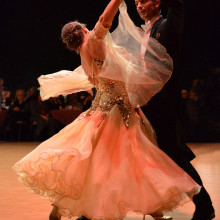
36:17 - The physiology of dancing
The physiology of dancing
with Prof Emma Redding, Trinity Laban Conservatory
What actually goes on the body when we’re dancing? How easy is it? It’s probably a pretty uncontroversial statement to say that dancers are fit, but how fit are they? To find out more, Adam Murphy and Izzie Clarke put themselves to the test with Emma Redding, Professor of Dance Science at Trinity Laban Conservatory of Music and Dance…
Emma - There are huge demands placed on dancers in terms of physiological demands. If you just look at how they take their bodies to huge extremes so in terms of joint range of motion they really do need to get their legs up. I mean they probably, I would say, dancers need to be more flexible than pretty much any other athlete. But, if you look at their upper body strength, and some of their cardiorespiratory fitness sort of areas, then dancers are less fit than many of their counterparts. Many sports athletes are actually fitter than dancers but that’s not because they don’t need to be fit, that’s just because the training needs to really support that fitness for the way in which choreographic demands are changing all the time.
Adam - So do dancers experience injuries at roughly the same rate as other athletes?
Emma - Dancers get injured a lot. Research has shown that 80 percent of dancers get injured in any 12 month period of time. That’s an injury that takes them out of participation. 80 percent of dancers, that’s a lot of dancers. And if you apply the same definition of injury and the same type of research to sports athletes, you’ll find that dancers actually get injured more than many other sports athletes, including rugby players, you know, and they’re killing each other. But actually, they get injured less, perhaps more catastrophic, but they get injured less than dancers. So it’s interesting and I think that one of the biggest causes of injury is fatigue and overwork, so that means we can do something about all those injuries in dance. Look at the training programmes, apply some science, and actually try and prevent those injuries.
Adam - But what does this application of science look like?
Scott - Well, this is the hand grip dynamometer. This is an isometric measure of strength. So we’re looking at particularly the forearm here, and the wrist.
Adam - That’s Scott Sinclair. Lab technician for Trinity Laban’s Dance Science Dept. Who had a test of strength for fellow Naked Scientist Izzie Clarke.
Scott - This is important, particularly within music and dance. One for musicians because they’re holding an instrument for quite a long period of time so if they’ve got an imbalance in their muscle weakness they’re more susceptible to injuries. The exact same principle as dancers; they’re working with the floor, they’re working with partners, so if they have a weakness or an instability, again, that could lead to injury as well.
Izzie - Okay. I’m so weak. I already know. I’m going to be so bad.
Scott - You just want to hold it in this position and squeeze as hard as you can for three seconds.
Izzie - Okay, right. Deep breath.
Scott - Ready… three, two, one, squeeze. Go go… one, two. three, and relax.
Izzie - Oh gosh. I wouldn't even know what that was.
Scott - That’s a three zero. So that’s measured in kgs. The most important bit really is just keeping it individual to you rather than comparing you to populations, for example.
Adam - That is all very helpful for dancers. But what about those of us who still struggle to clap in time? Back to Emma Redding…
Emma - One of the big things we’re trying to do here at Trinity Laban in dance science is to measure the impact of dance on the health and wellbeing of other populations. And there’s been a lot of anecdotal evidence really in the press and magazines and on TV about what dance can do, and dance is certainly more popular than ever before. More people are doing dance and watching dance, funnily enough. And why is that, what is it doing for them? And that’s we’re trying to sort of measure.
We know that dance can get you fitter. So if it’s seen as a physical activity just like any sport then it can potentially conquer various diseases like obesity, diabetes, cancer, heart disease, etc.
What else can dance do? We measure the psychological impact of dance, and we’ve found with some of the research projects we’ve done, we’ve found that, for example, older people can increase their self-esteem, their sense of identity and purpose and meaning in life through dance participation.
Adam - Do you have any theories as to why it does that?
Emma - Yes. Dance is not just a physical activity, it’s a social activity whereby people are touching each other, they are interacting with each other. Trying physically and cognitively to solve those problems together. So I think it’s the social, the cognitive, and the physical aspects of dance that makes dance a very unique activity and can produce the benefits that go way beyond sports.
Adam - We decided to put this to the test and went for a dance class with Emma who was more than happy to put us through our paces with a simple contemporary routine…
Although how simple it actually was is up for some debate…
Izzie - I obviously can’t tell my left from my right apart. One left, one right... got it. Change direction… I don’t got it.
Adam - And at the end of the somewhat successful class, had Emma proved us right? Were there real psychological benefits?
Emma - Well, I can see you’re smiling. So I think it’s fair to say that yes, there are lots of psychological benefits. I can see them now. And what's happening essentially is those exercise endorphins that are released when you do any physical activity, they are being released right now. So you’re feeling good about yourself, you’re feeling happy. Everyone seems to walk out of dance class with a smile on their face.
Adam - Are there any particular groups of people who benefit most from getting involved in dance?
Emma - No. I would say all types of people, no matter who you are, what you come with, you can benefit from dance. Every individual that has participated in dance, at least at Trinity Laban, has benefitted in some way. And we do work with older people; we do work with people who have acquired brain injury; younger people with learning differences; people with physical difficulties; we have people in wheelchairs coming in with their carers. And it’s really important for us as well to not only work with the people who have those differences but their carers, their physiotherapists, occupational therapists so that they can go out of the building and actually continue to be creative physically with the people looking after them as well.
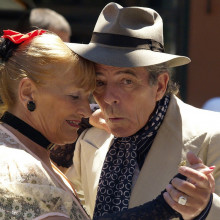
Dancing for wellbeing
with Debra Quartermaine, Addenbrooke's Hospital
Dance can be a great help to many people, including the elderly. But what do programmes like this look like, and what kind of help do they offer. At Addenbrooke’s Hospital in Cambridge, the Dance for Health Programme does just that. Debra Quartermaine is the Falls Prevention Co-ordinator and the Coordinator for the Dance for Health Program in Addenbrooke’s joined Georgia Mills and took her through how the programme started.
Debra - I am a dancer by background as well as a nurse, and in 2013 I had a conversation with our Arts Department,to see whether we could bring dance into the hospital for patients. There’s a lot in the community but not within a hospital setting. So our Charitable Trust funded us a pilot program, which was incredibly successful and it’s carried on from there. And back in 2017, we were lucky enough to get two years funding from the Dunhill Medical Trust, and part of that was to do research on the program as well. So we’re nearing the end of that but it’s gone down very well and has had some very positive results.
Georgia - Can you talk me through what a typical session might look like then?
Debra - There is never really a typical session. To bear with, we are actually dealing with very sick patients here so it’s very patient led. We have a skeletal structure which is a warm up, and then improvisation, and then a relaxation session at the end of it. But it very much depends on the patients that come in, what their abilities are, and what they would like to do.
Georgia - I see. So are there any sort of moves that you could teach us now in the studio.
Debra - We do start off with trying to ground people by making sure they’ve got their feet both on the floor if they can. And just put your hands on your thighs and just literally very slowly moving your hands up and down your thighs.
Georgia - Okay. I feel like Vic Reeves here.
Debra - I know that sounds very strange but we’re looking at people’s proprioception, so do they know where their hands are, do they know where their legs are?
Georgia - Right. And is that a good indicator of their wellbeing?
Debra - Well, it’s an indicator that they know where the position of their body is. So if I was to blindfold you, you would know where your hands are. You’d know whether they were above your head, or hanging down by the side. Some people, if they have a neurological disorder don’t know that so we’re trying to judge what we need to work with with those patients.
Georgia - I see. And is it also an advantage some people being less mobile so you don’t need to do a conga line, you can do it from a seating position?
Debra - Yes. A lot of ours are seated. We can stand up, but sometimes we are working with getting patients to stand and that will often take two of us to do that, and then getting them to dance while they’re standing up. There is never one session the same. It’s incredibly interesting to walk in. And the one thing we do always say is we don’t want to know what the diagnosis of the patient is, we are purely working from looking at their body and listening to them.
Georgia - And why dance instead of just the regular physio?
Debra - Physio is very prescriptive. So, you know, you need to bend this arm ten times and it’s quite boring. How many of us really like to go to the gym?
Georgia - Not me! I’ll say straight away.
Debra - And obviously, at the moment, we’re dealing with the elderly so it’s an age group that are very used to dancing. They often met their partners at dance halls, spent Saturday nights at dance halls. They don’t see it as a form of exercise, they see it as a form of enjoyment.
Georgia - And you mentioned you’re researching the effectiveness, so what have you found so far? How effective has it been?
Debra - Part of the research that’s been going on is looking at wellbeing. And the preliminary results from that is showing that over 70 percent of the patients who attend the sessions have an improvement of their wellbeing from the beginning to the end of the sessions.
Georgia - Right. So that’s quite positive. Individually, have people been reporting they’ve found benefits?
Debra - We have. We’ve had a very interesting case not long ago where we’d had a gentleman who’d been in the hospital for quite a number of months who’d basically given up. He wouldn’t engage in physiotherapy; he wasn’t getting out of bed; he wasn’t eating very well, and he was heading towards a nursing home, which would have split him up from his wife. We managed to get him into the session; he started to engage. After a couple of weeks he was bringing in his playlist of music that he wanted. He was then starting to ask when his physiotherapy sessions were. And we kept working with him, together with the physiotherapists doing their bits as well, and we got him home.
Georgia - Wow, that’s fantastic! The power of dance. So are people, in general, when they hear they’re going to be dancing around, are they excited are or they a bit skeptical at first?
Debra - We’ve had to sort of use the word ‘movement’ rather than dance with a lot of people because they have a vision of Strictly. Getting up and having to learn steps.
Georgia - Wearing a sequined suit.
Debra - Yep. and that’s definitely not what it’s about. It’s things like we had a gentleman and his wife was in visiting and they used to ballroom dance, but they hadn’t been able to dance for six months because he could no longer stand. We managed to get him up and put a piece of lovely waltz music on and allow him to dance with his wife. Two of us supported him while he held his wife and danced with her, and I think that was worth a million pounds to see that.
Georgia - That’s beautiful. Are there any other programs like this?
Debra - No, this is unique. There are dance programs where performers go into hospitals and do performances. But our program is not around that so it’s a very unique program. There’s no other hospital in the UK doing it. We don’t think there’s any other hospital in the world doing it.
Georgia - Right. And so what is next then? Spread the good word, I guess.
Debra - Well, we’re now looking for more funding. We’d like to extend the program; we’d like to continue with what we’re doing but extend it. We’d like to work with different groups of patients so orthopedics, transplant, all of those sorts of things.

49:50 - Why do wombats Have cube-shaped poo?
Why do wombats Have cube-shaped poo?
Tamsin Bell asked Dr Louise Gentle from Nottingham Trent University to help us out with this stinker…
Louise - The wombat is unique in the animal kingdom because it produces cube shaped poo and lots of it - around 80 to 100 cubes per night. Now the wombat is a nocturnal animal with poor eyesight, but an excellent sense of smell. It is highly territorial, so uses its cube shaped poo to mark its territory and prevent conflict.
Wombats deposit poo outside their burrows and on top of rocks and logs where they’re more easily found by other wombats. So, wombats use poo as their main way of telling who lives where, if there are any other unknown wombats in the area, and also as a way of increasing its reproductive success.
Tamsin - So now we have an idea of why wombats produce a lot of cubic poo, but how is it actually produced?
Louise - Well, wombat poo is cubic. Not because the wombat has a square shaped anus, but because it has a very long and slow digestive process. Typically two to three weeks, which makes the digestive matter extremely compacted and dry.
Tamsin - Woah! Two to three weeks. They must feel bloated all the time. Wombats have the driest poos compared to other mammals or marsupials, and these poos contain really really fine grass particles, the main part of their diet.
Louise - The first part of their long digestive tract contains ridges that mold the faeces into cubes; whereas the last part of the intestine is relatively smooth allowing the cubic shape to be maintained. The ridges in the digestive tract may cause weaknesses in the poo which make it susceptible to breaking into smaller cubes. The highly compacted nature of the poo means that the anus is unable to contour it into the usual tubular shapes, so it stays in the shape of the cubes that were formed at the start.
Basically, the wombat produces hard cubic poo as a result of its diet and long digestion. Most poo is moist so sticks where it is deposited, but the distinctive cube shape is thought to be advantageous to the wombat as it stops the hard dry poo from rolling away down the steep mountains that the wombat inhabits.
Tamsin - Wow! That is a very clever adaptation. Thank you Louise for pooting the lid on that one.
Next time, we’re considering this time travelling question from Stuart:
If you could bring a baby from the past to grow up in the present, how far back could you go before people would notice that this was a time travelling baby?
Related Content
- Previous Why do wombats poo cubes?
- Next Why do we need sleep?










Comments
Add a comment